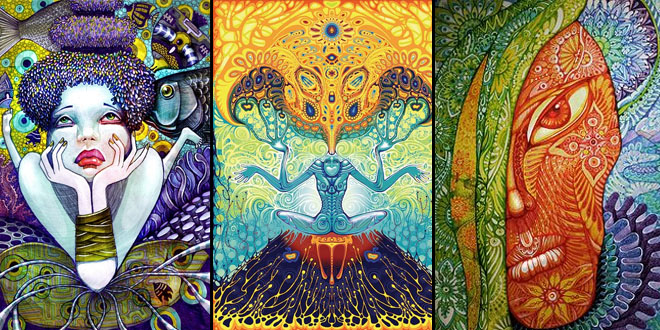
Artist makes self-portraits after small LSD intake
An artist makes self-portraits after taking LSD. LSD is one of the most dangerous, mood-changing chemicals and a hallucinogen. It is manufactured from lysergic acid, which is found in the ergot fungus that grows on rye and other grains.
Hallucinogens such as LSD usually fabricate a person’s perception. Hallucinations occur, changing one’s thoughts, consciousness and emotions. It creates sensitivity-altering effects by acting on serotonin – a neurotransmitter of the brain that controls perceptual, behavioral and regulatory systems.
Its major effects occur in the prefrontal cortex of the brain. Mood, perception and cognition are involved in this area. Areas which regulate arousal and control physiological responses to panic and stress are also affected.
Between 1953 and 1964, the CIA used LSD and conducted a series of tests on fellow Americans and counter Russians under the MK-ULTRA program. This is before the drug fell in the hands of hippies and drug smugglers.
The LSD drug tests were carried out as they believed that the Russians were doing it on captured Americans.
Because it didn’t want to fall behind, the CIA began its own experiments. They secretly slipped acid in the drinks at the beach, in city bars and restaurants – breaking all ethics of experimentation.
Their agents just followed and observed without intervening – though eventually it was found to be useless for extracting any data.
Nowadays, the drug is manufactured into crystal forms in illegal small labs, which are converted to liquid state for distribution. The drug has a very slight bitterness taste to it, though it is odorless and colorless.
It is sold in forms of tablets, ‘microdot’ capsules, in squares of gelatin, in absorbent paper or at times liquid. Regardless of the drug form, its consumption takes a person far off from reality, where users call it a “trip.”
LSD can often induce a “bad trip” – an experience as if you’re living “hell on earth” – for users of the drug.
SHORT TERM EFFECTS OF LSD
LSD increases body temperature, heart rate and blood pressure. It causes dizziness and sleeplessness, loss of appetite, sweating, dry mouth, numbness, weakness, and tremors. One can become impulsive and emotions can change fairly quickly, from fear to a sense of elation. The emotional transitions can be so rapid, that the user can experience several emotions at the same time. The drug may also cause nausea.
Depth and perception of time can become impaired, as can the size and shape of objects, sound, body image, color, touch and movements. Panic can be caused by fear of these changes. Severe, terrifying thoughts and feelings, fear of insanity and death, and fear of losing control can be experienced.
After an LSD trip, a user may go through depression or anxiety (or both), and flashbacks can also occur, which are recurrences of the last “trip” from days or even months ago. A flashback happens all of a sudden, usually in people who habitually use hallucinogens or have an underlying identity/personality issue. Bad Awful outings and flashbacks are just piece of the dangers of LSD utilization.
In case the short-term effects do not deter you away from drugs, in particular LSD, one should remember that there are long term effects.
LONG TERM EFFECTS OF LSD
The ability to make sensible judgments and see normal risks is hindered under the influence of LSD, making the user powerless to self-harm, which can become lethal.
LSD users create a large degree of tolerance for drugs such that repetition of the drug would require increasingly higher doses to cause similar effects as earlier. This also causes an urge for more drugs of the same class.
Long term psychoses, for example serious depression or schizophrenia, might manifest in users.
These eventually lead to illnesses such as persistent psychosis and Hallucinogen Persisting Perception Disorder (HPPD). It creates visual disturbances, disorganized thinking, paranoia, mood disturbances, hallucinations and neurological disorders such as stroke or brain tumor.

